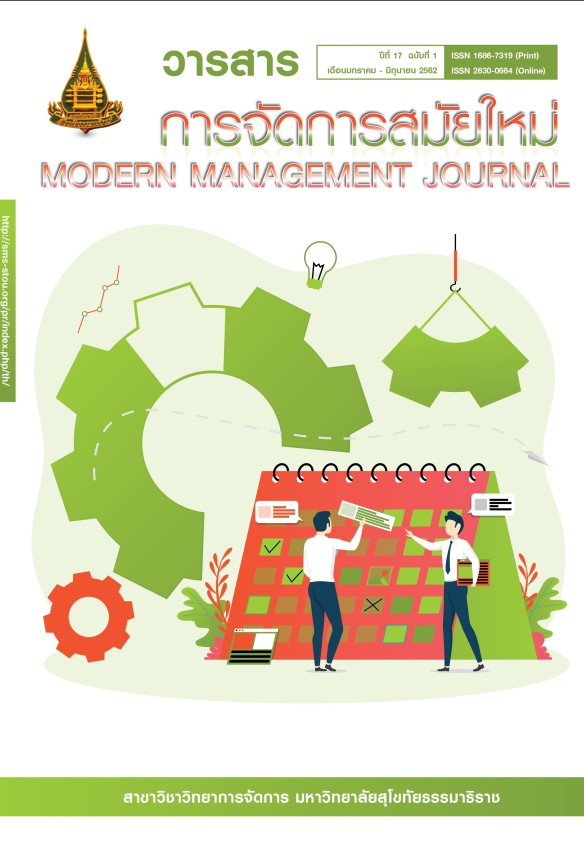HUMAN RESOURCES DEVELOPMENT OF MANUFACTURING EMPLOYEES IN ELECTRICAL AND ELECTRONICS INDUSTRY
Keywords:
Human Resources Development, Manufacturing Employee, Electrical and Electronics IndustryAbstract
This research aimed 1) to study the composition of human resource development in manufacturing department of electrical and electronic components industry; 2) to study and develop a process of human resource development of manufacturing employees in electrical and electronic components industry; and 3) to develop a guide for human resources development in electrical and electronic components industry. This research was mixed method study. For the quantitative research, samples were 174 production and HR executives from 87 electrical and electronic components industry. The research instruments were questionnaires. The statistics used for data analysis were Means and Standard Deviations. For qualitative research, samples were purposively 6 high level executives in electrical and electronic components industry and HR scholars. The research instruments were in-depth interview guideline and the analysis was conducted by content analysis.
The research found out that 1) human resources development process in electrical and electronic components industry consisted of 4 elements as follows: Individual Development; Career Development; Performance Management; and Organizational Development. In all 4 elements, there are 9 interrelated steps: Step 1 human resources development defining, Step 2 annual review of responsibilities, Step 3 recruitment and selection, Step 4 assessment of needs in development, Step 5 human resources development plan defining, Step 6 criteria and expectations in development determining, Step 7 orientation, Step 8 individual development plan defining and lastly Step 9 development result summarizing on the actual work. 2) According to case study with the companies, it was found that the process of human resource development in manufacturing department of electrical and electronic components industry are difference. Employees have participated to create self-development plan at a high level to be competitive with business situation and able to cope with future changes, human resource development needs to go through analytical thinking processes from all section in the organization. Especially, human resource development plan has to be linked and aligned with business plan and strategic plan of the organization (SHRD: Strategic Human Resources Development). The aim of development should promote short-term and long-term business performance and prevent risk of negative impact on the business in the future. 3) the researcher has developed a manual that aims to guide human resource development in manufacturing department of electrical and electronic components industry. It is conclusive that human resource development manual evaluated by manufacturing employees will be useful to the organization at the highest level and can be used practically and appropriate to the electrical and electronic components industry at a high level.
References
Arnauld de Nadaillac. (2003). Competency System. London: McGraw-Hill.
Boyatzis, R.E. (1982). The Competent Manager: A model of Effective Performance. New York: John Wiley and Sons.
Dubois, D., & Rothwell, W. (2004). Competency-Based Human Resource Management. CA: Davies-Black Publishing.
Delahaye, B.L. (2000). Human Resource Development Theory to Practice. Morton: John Wiley & Sons Australia.
Gilley, J.W., & Eggland, S.A. (2002). Principle of Human Resource Development. Cambridge, M.A.: Perseus.
Gilley, J.W., Eggland, S.A., & Gilley A. M. (1990). Principle of Human Resource Development. New York: Addision Wesley.
Kritchana, W. (2553). The Development Work Competency of Production Managers in Electric and Eectronic Industries. Faculty of Applied Arts : King Mongkut’s University of Technology North Bangkok [In Thai].
McClelland, David C., (1973). Testing for Competence rather than Intelligence. New York: Harper and Row.
Puwittayapan, A. (2011). Performance Indicator (Pls) Directory. Bangkok: H. R. Center. [In Thai].
Staples, J.G. (2010). The relationships among employee reactions to training, commitment to organizational change, learning, and volunteering behabvior. Dissertation Abstract International 71(04), 0624-A.
Swanson, R.A., & Holton, E.F. (2009). Foundations of Human Resource Development. San Francisco, CA: Berrett-Koehler Publisher.
Yorks, L. (2005). Strategic Human Resource Development. South-Western: Thomson Coporation.



